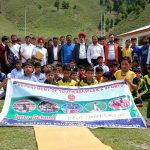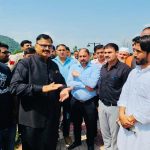PROGRESS AND POWER
At the stroke of midnight on 15th of August 1947, India gained independence, marking the beginning of a new era filled with both challenges and hopes. Though freedom was a moment of celebration, the country faced widespread poverty and required a clear roadmap for recovery and growth. Through a mix of small steps and major reforms, India began its journey of progress across sectors.
Among all, agriculture stands out as a remarkable success—from struggling to feed its population to becoming a global food producer, thanks to milestones like the Green and White Revolutions. Yet, despite significant achievements, India remains a developing nation. Now, it is time for a decisive leap toward becoming a developed country.
In December 2023, as India was still emerging from the impact of the COVID-19 pandemic, Hon’ble Prime Minister launched the visionary goal of Viksit Bharat—a roadmap to transform India into a developed nation by 2047, its 100th year of independence. More than just a slogan, Viksit Bharat embodies the ambition of becoming a global leader (Vishwaguru), drawing strength from India’s rich legacy, technological progress, vast workforce, and demographic advantage. The journey toward this goal is now underway.
The Numbers Game
India’s villages form the backbone of the nation, with around 60% of the rural workforce employed in agriculture as of 2023-24. Agriculture and allied sectors contribute a significant 18% to the country’s Gross Value Added (GVA). Notably, the livestock sector alone accounts for 30.23% of Agricultural GVA and 5.50% of total GVA, registering a growth of 5.02% over the previous year.
India leads the world in milk production and ranks 2nd and 5th in egg and meat production, respectively. These achievements reflect the tireless efforts of the veterinary workforce, particularly veterinary doctors, who ensure effective implementation of government schemes at the grassroots. Their role spans across animal breeding, nutrition, management, and welfare.
And the rise of women veterinarians has further strengthened the profession, as they contribute equally to driving meaningful, on-ground impact.Women veterinarians have broken gender stereotypes and proven their value in the veterinary field through dedication, intelligence, and compassion, contributing significantly to the livestock sector’s growth. Their role, alongside male counterparts, is crucial in achieving the ambitious goals set for Viksit Bharat by 2047, including boosting livestock productivity, reducing diseases, and ensuring self-sufficiency in animal products.
The Four Pillars of Viksit Bharat and the Role of Women Veterinarians
The vision of Viksit Bharat stands on four core pillars: Yuva (Youth), Garib (Poor), Mahila (Women), and Annadata (Farmers).
Women veterinarians play a vital role in strengthening each of these pillars, contributing directly to the nation’s growth.
- Yuva (Youth) – Empowering Young Entrepreneurs: Government schemes aim to turn youth from job seekers into job creators. Women veterinarians have been instrumental in this transformation by conducting outreach and skill-based training, particularly under initiatives like the Integrated Dairy Development Scheme (IDDS) and Holistic Agriculture Development Programme (HADP), helping young people become successful entrepreneurs.
- Garib (Poor) – Supporting Livelihoods: Most livestock farmers in India are poor and resource-constrained. Women veterinarians ensure veterinary services reach even the remotest areas, providing essential breeding and healthcare support, thereby improving the standard of living for poor farming families.
- Mahila (Women) – Promoting Women’s Empowerment: Women are the backbone of livestock farming, often handling day-to-day care without formal recognition. Women veterinarians, through better communication and understanding, help uplift women farmers by promoting Self Help Groups (SHGs) and ensuring they access training, support, and fair opportunities.
- Annadata (Farmers) – Enhancing Productivity: Farmers play a critical role in ensuring national food security. Women veterinarians assist them by spreading awareness about modern breeding, nutrition, and management practices, helping boost livestock productivity and income, and advancing the goal of a prosperous farming community.
The Nari Shakti- Tapping the potential of Women Veterinarians
Undoubtedly, women veterinarians hold a crucial role in achieving the vision of a Viksit Bharat, as they actively contribute across multiple sectors of veterinary science.
- Disease Control and Eradication: India’s diverse livestock population is a vital economic resource but often faces the threat of disease outbreaks, including zoonoses. Women veterinarians are at the forefront of disease surveillance, vaccination, and prevention, playing a key role in national initiatives like the NADCP.
- Animal Breeding and Conservation: Women veterinarians are instrumental in advancing animal breeding programs, which have significantly boosted milk production and breed quality in India. Through efforts in artificial insemination and use of sex-sorted germplasm, they continue to drive genetic improvement and sustainable livestock development.
- Implementation of Schemes and Veterinary Extension: By actively engaging in veterinary extension, women veterinarians ensure that government schemes and scientific knowledge reach grassroots farmers, improving their livelihoods and enhancing livestock productivity.
- One Health and Animal Welfare: Women veterinarians help integrate the ‘One Health’ approach by promoting awareness about zoonotic diseases, ensuring both human and animal well-being, and educating communities on responsible animal care.
- Research and Development: Despite limited resources, women veterinarians lead important research on livestock diseases, pathogens, and treatment strategies, contributing to the growth of veterinary science and animal health innovation.
- Food Security and Quality Control: Women veterinarians ensure the safety and quality of animal-origin food products, playing a key role in combating malnutrition and food adulteration as food safety officers and inspectors.
The Challenges
While women veterinarians have earned recognition nationwide, gender bias remains a challenge that must be addressed through collective action. The livestock sector also faces growing threats from climate change, emerging zoonotic diseases like Lumpy Skin Disease, and antimicrobial resistance (AMR).
Women veterinarians play a key role in educating farmers on the responsible use of antibiotics to combat AMR. Additionally, improving veterinary infrastructure is essential to create a supportive work environment and unlock the full potential of the veterinary workforce.
Conclusion
The livestock sector has shown promising growth, contributing 5.5% to the GDP, and is expected to increase to 8-10% by 2047, according to NITI Aayog. Veterinarians, both male and female, must rise to the challenge of ensuring this growth, despite the difficulties ahead. Women veterinarians, with the right infrastructure and support, are key to achieving the goal of a developed India by 2047. Their contribution will be crucial in realizing the vision of a Viksit Bharat.
(The Author is Veterinary Assistant Surgeon, Animal Husbandry Department, Kashmir. Email: [email protected])










Nicely presented the perspective of female vets Dr Mehreen. I remember Dr Mehreen on a horse back going on a hilly tract to treat an animal. Happy WVD 25 Dr Mehreen and our lady veys.